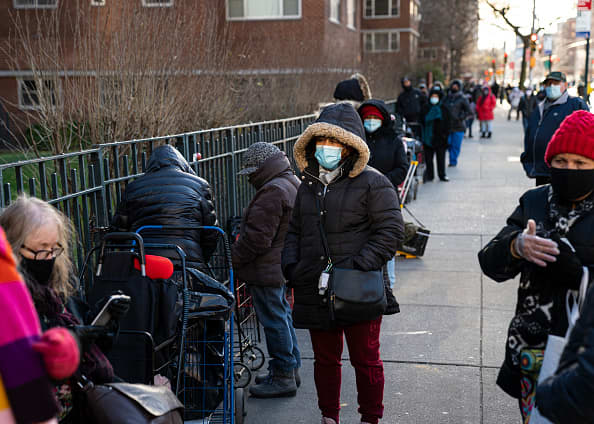
People wait in line at the Holy Apostles Soup Kitchen on Dec. 15, 2020 in New York City.
Robert Nickelsberg | Getty Images
The latest coronavirus relief bill passed by Congress will give some unemployed workers an additional $400 per week — an extra $300 on top of state benefits authorized for most claimants plus another $100 for some who had multiple sources of income.
But the extra $100 will only come if states opt in, and it could take more than a month for workers to see it in a weekly check.
The additional $100 per week is a rough fix for so-called mixed earners — workers who had income filed on both W-2s and the 1099 forms used by freelancers, independent contractors and other self-employed workers. When filing for unemployment, these workers were often given state benefits that reflected only their W-2 income, not their total earnings, resulting in a lower weekly amount.
To qualify for the additional $100, workers must have received at least $5,000 in self-employment income in 2019. Those eligible will be able to receive the extra money for the weeks from Dec. 27, 2020 through March 14, 2021, according to the bill text.
State decision
The Covid relief bill also gives states the ability to opt out of giving mixed earners the extra $100. This isn’t due to the cost to the states — the money is from the federal government — but because of the administrative work it will take to get the system up and running.
“Some of it is just that it’s really hard to implement,” said Michele Evermore, senior policy analyst at the National Employment Law Project. “[States] are going to have to get their computers to talk to each other in a way that they hadn’t before.”
It remains to be seen if any states will choose not to accept the extra money for their mixed-earner constituents. The fix is not as difficult a process to implement as the Lost Wages Assistance program passed by President Donald Trump in August, which extended an extra $300 per week plus $100 from state funding to some unemployed workers, according to Evermore.
“I don’t see states turning down free money because of a little bit of implementation challenge,” said Evermore. Still, it is not impossible that states would pass on the program — South Dakota opted out of LWA because of its complexity, she noted.
More from Invest in You:
Add these costs to your budget to plan a safe vacation during Covid
How to craft New Year’s resolutions that you won’t break right away
Bitcoin hit $20,000 for the first time ever. Should you invest?
What is perhaps more likely is that the complexity of implementing the program means that it will take a few weeks to get up and running, said Evermore.
Experts have estimated that there will be a three- to six-week gap before unemployed workers start seeing the extra $300 per week in their unemployment checks. It’s likely that mixed earners will have to wait even longer to see the additional $100.
“People are going to have to document that they have at least $5,000 in 1099 income, so it might take a bit for states to have some sort of process in place to review those documents,” said Elizabeth Pancotti, policy advisor at Employ America, a left-leaning advocacy group.
More information about how states should handle these programs will likely come from the Department of Labor after the first of the year, she added.
“Folks should not spend right now in anticipation of getting that check in two weeks,” she said.
The fix is a win — but experts hope there’s more to come
The fix will help mixed earners who have not had their full income counted for benefits, giving some further aid to those who are unemployed. Still, it falls short of the need for many that have been slammed by the pandemic.
“It’s a win because something happened,” said Stephanie Freed, co-director of ExtendPUA.org, a grassroots campaign started because of the pandemic.
But the bill is also inadequate, she said, because none of the payments in the bill are retroactive, including the fix for mixed earners, some of whom have been getting lower benefits for nine months.
“We’re really interested in how the administration and the new Congress go back and find a way to fill the gap,” she said.
SIGN UP: Money 101 is an 8-week learning course to financial freedom, delivered weekly to your inbox.
CHECK OUT: Suze Orman: Don’t pay off debt with a second stimulus check — here’s your ‘first priority’ via Grow with Acorns+CNBC.
Disclosure: NBCUniversal and Comcast Ventures are investors in Acorns.




